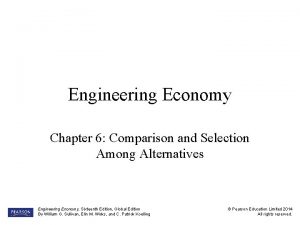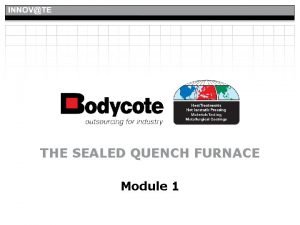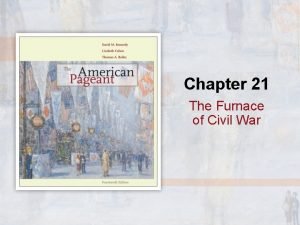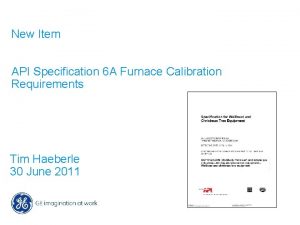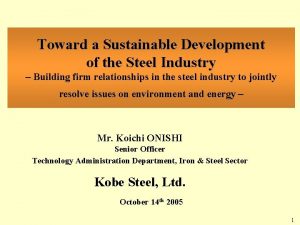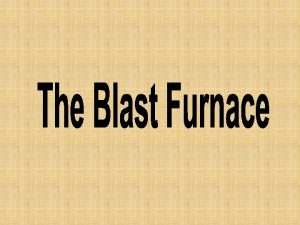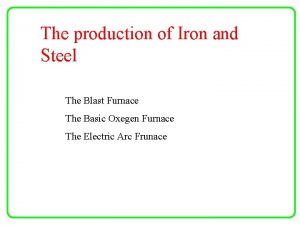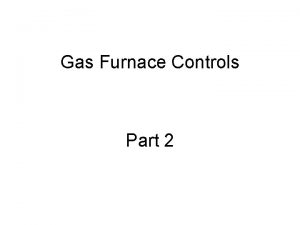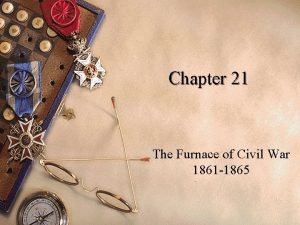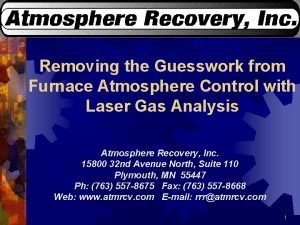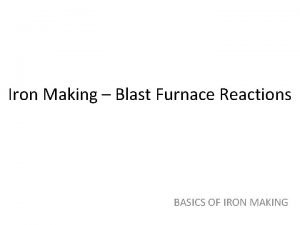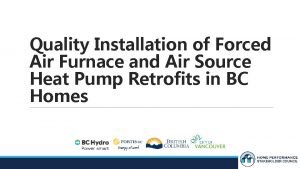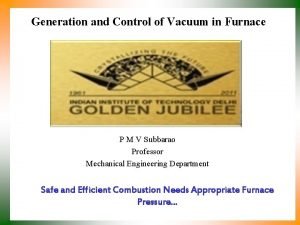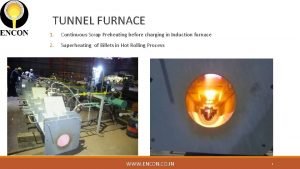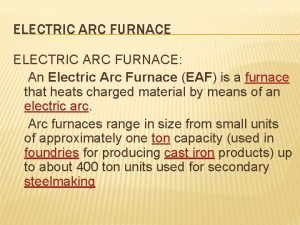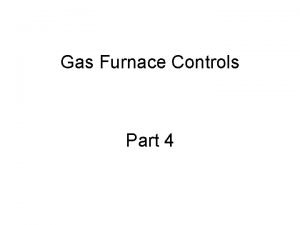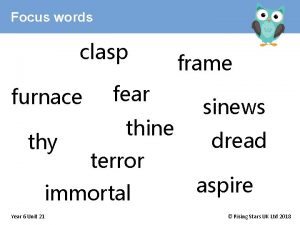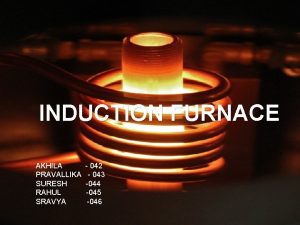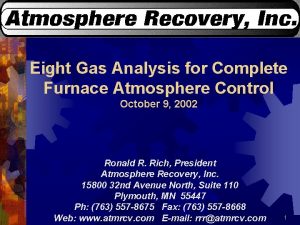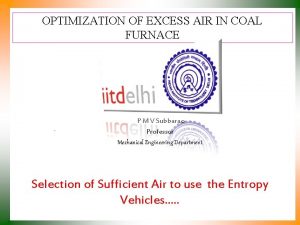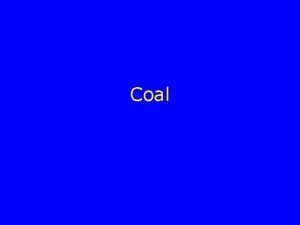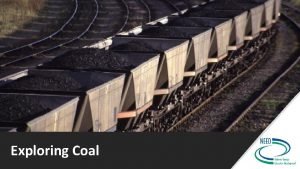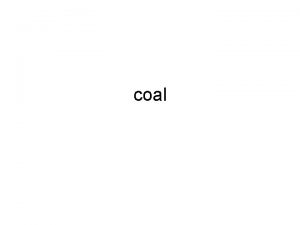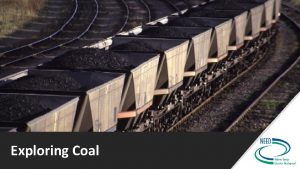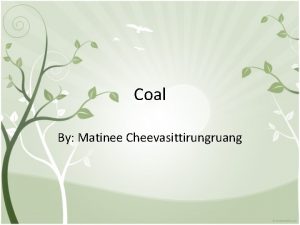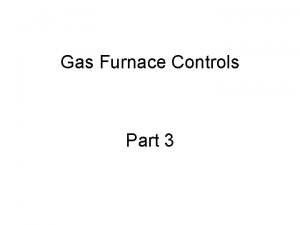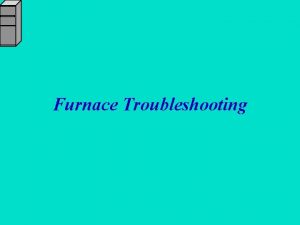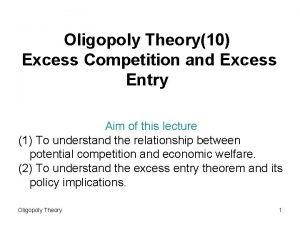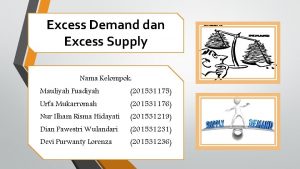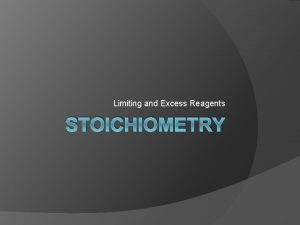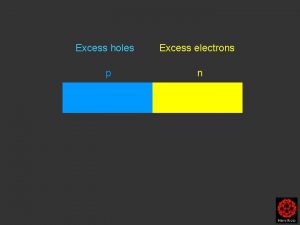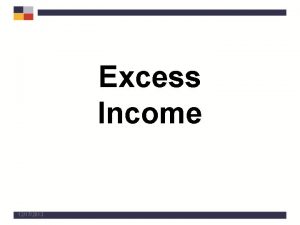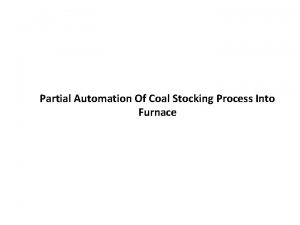OPTIMIZATION OF EXCESS AIR IN COAL FURNACE P





















- Slides: 21

OPTIMIZATION OF EXCESS AIR IN COAL FURNACE P M V Subbarao Professor Mechanical Engineering Department Selection of Sufficient Air to use the Entropy Vehicles…. .

Typical values of Excess Air vs Fuels Solid Liquid Gas Coal(P) Coke Wood Bagasse Oil Natural Gas Refinery gas Blast-furnace gas Coke-oven gas % Excess air 15 -- 30 20 -- 40 25 -- 50 25 – 45 3 – 15 5 – 10 8 – 15 15 – 25 5 - 10

Typical Layout of A Model Furnace Hchimney Tatm TCh, gas p. A = pfan. f B B Fuel A p. B = pfan, s

Air Supply Systems

Energy Potential of Post Combustion Gases Total Thermal Power of post combustion gases: Thermal Power of Chimney gases with heat Exchange to working fluid : Total Thermal Power of gases available for Utility:

Measures of Inefficient Combustion Unburned carbon losses • For every 100 kg of fuel (as received) • QUCL = nc * MC * Calorific Value of Carbon : k. J • QUCL = nc * 12 * 33820 k. J. Incomplete combustion losses • For 100 kg of fuel (as received): • QICL = n. CO * MCO * CV of CO. k. J. • QICL = n. CO* 28 * 23717 k. J.

Selection of Optimal air for Best Performance Air-Fuel Ratio

Results for Best Efficiency

Effect of Excess Air on Emissions

Selection of Optimal air for Eco-Friendliness

Learning about Impact of Excess Air

Study of Impact of Excess Air

Unified Optimization Methods

Methods to Apply the Optimization

Monitoring of Optimal Excess Air

Air Ingression Due to Better Combustion Conditions

Effect of Air Ingression on Actual Available Excess Air

Excess Oxygen at Furnace Exit

13 Essentials of Optimum Combustion Fuel Preparation 1. Fuel feed quality and size shall be consistent. 2. Fuel feed shall be measured and controlled as accurately as possible. Load cell equipped gravimetric feeders are preferred. 3. Fuel line fineness >75% passing a 200 -mesh screen, and 50 mesh particles <0. 1%. Distribution to Burners 4. Primary airflow shall be accurately measured and controlled to ± 3% accuracy. 5. Primary air to fuel ratio shall be accurately controlled when above minimum. 6. Fuel line minimum velocities shall be ~ 15 m/s. 7. Fuel lines shall be balanced by “Clean Air” test to within 2% of average. 8. Fuel lines shall be balanced by “Dirty Air” test to within 5% of average. 9. Fuel lines shall be balanced in fuel flow to within 10% of average.

13 Essentials of Optimum Combustion Distribution to Burners 4. Primary airflow shall be accurately measured and controlled to ± 3% accuracy. 5. Primary air to fuel ratio shall be accurately controlled when above minimum. 6. Fuel line minimum velocities shall be ~ 15 m/s. 7. Fuel lines shall be balanced by “Clean Air” test to within 2% of average. 8. Fuel lines shall be balanced by “Dirty Air” test to within 5% of average. 9. Fuel lines shall be balanced in fuel flow to within 10% of average.

13 Essentials of Optimum Combustion 10. Over-fire air shall be accurately measured and controlled to ± 3% accuracy. 11. Furnace exit shall be oxidizing; 3% oxygen is preferable. 12. Mechanical tolerances of burners and dampers shall be ± 1/4��’’. 13. Secondary air distribution to burners shall be within 5 -10% of average.
 Hubungan air dengan tanah
Hubungan air dengan tanah Methods of comparing alternatives in engineering economy
Methods of comparing alternatives in engineering economy Sealed quench furnace price
Sealed quench furnace price The furnace of civil war
The furnace of civil war Asme 2750 furnaces
Asme 2750 furnaces Rotary hearth furnace
Rotary hearth furnace Blast furnace charge
Blast furnace charge How is steel made
How is steel made Furnace solenoid
Furnace solenoid The furnace of civil war
The furnace of civil war Furnace atmosphere control
Furnace atmosphere control Naumann reversion reaction
Naumann reversion reaction Fortis commissioning sheet
Fortis commissioning sheet Furnace
Furnace Induction tunnel furnace
Induction tunnel furnace Electric arc furnace temperature
Electric arc furnace temperature Flame rectification
Flame rectification In what furnace was thy brain
In what furnace was thy brain Disadvantages of induction furnace
Disadvantages of induction furnace Daniel's friends in the fiery furnace
Daniel's friends in the fiery furnace Introductory performance review
Introductory performance review Furnace atmosphere control
Furnace atmosphere control

